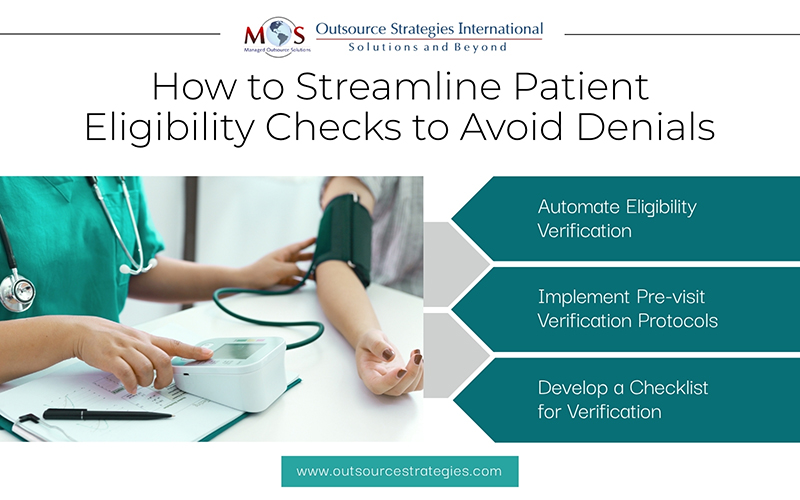When it comes to healthcare providers, the revenue cycle is not just about delivering care – it is also about ensuring that every claim submitted gets efficiently reimbursed. One of the most overlooked yet critical steps in the medical billing process is insurance eligibility verification. Even small errors in eligibility verification can have significant implications for both healthcare providers and patients. Inaccuracies, such as incorrect insurance information or outdated coverage changes, can result in adverse outcomes such as denied claims, delayed reimbursements, and total loss of revenue for healthcare facilities. Understanding how patient eligibility verification mistakes lead to claim denials is essential for any healthcare organization striving to improve financial performance and patient satisfaction. This article will highlight how insurance eligibility verification mistakes impact claims.
The Role of Patient Eligibility Verification in the Revenue Cycle
Patient eligibility verification is the process of confirming a patient’s insurance coverage and benefits before services are provided. Typically, this verification occurs during patient intake or scheduling and it sets the base for the entire billing process. The process includes checking:
- Whether the patient’s insurance is active
- The scope of coverage for specific procedures
- Co-pays, deductibles, and coinsurance
- Network status of the provider
- Pre-authorization requirements
If done correctly, it enables a smoother path to reimbursement. On the other hand, if not done correctly, it becomes a primary reason for claim rejections and denials.
Reduce denials and protect your revenue.
How Eligibility Verification Errors Lead to Claim Denials
One of the most frequent causes of insurance claim denial is inaccurate or incomplete insurance information. Here are some of the most common verification mistakes that healthcare providers make:
- Failure to Verify Coverage Prior to Service: When the healthcare provider assumes that the patient’s insurance is active without actually confirming it, claims can be denied due to coverage lapses or expired policies.
- Coverage Discrepancies: Insurance coverage verification errors occur when healthcare practices fail to thoroughly verify the specific services covered, limitations, and changes in the patient’s details. Coverage verification errors usually happen due to an oversight of the policy details by the front-end staff. Coverage discrepancies result in partial reimbursement or underpayment for the services rendered. They can also lead to prolonged dispute-resolution sessions with the payer. In short, efficient patient eligibility verification enables practice owners to secure full reimbursement for services and maintain a financially sustainable practice.
- Incorrect Patient Information: Even a minor error – such as incorrect/misspelled patient names, addresses or contact information – can trigger a denial. Inaccurate patient information significantly increases the likelihood of claim denials, causing considerable financial setbacks for practice owners. If it isn’t outright claim denials, incorrect patient information during eligibility verification significantly expands reimbursement timelines, leading to disputes with insurance providers. Insurance companies have strict data matching rules, and any inconsistency can lead to automatic rejection.
- Ignoring Authorization Requirements: Some services require prior authorization. If that step is missed due to flawed eligibility verification, the claim is typically denied – regardless of medical necessity.
- Neglecting Secondary Insurance Verification: When patients have multiple insurances, failing to verify and properly coordinate benefits can lead to denials or delayed reimbursement.
- Incorrect Policy Information: Even a minor error such as an incorrect group number or a misspelled name – can trigger a denial. Insurance companies have strict data matching rules, and any inconsistency can lead to automatic rejection.
- Inadequate Benefit Verification: There are many nuances to the benefits patients get from payers. Hence, it requires a watchful eye to identify them accurately. Oversights in verifying details such as coverage for prescription drugs, preventive services, or specific medical procedures directly affect reimbursements. Inadequate benefit verification leads medical practitioners to underestimate the services covered by the patient’s insurance plan. It results in billing loss for certain covered services and a long chase for practitioners to resolve reimbursement issues.
- Inaccurate Provider Information: Incorrect details about the healthcare provider or care facility during the insurance verification process can affect claims just as much as incorrect patient information. Errors related to provider information usually encompass inaccuracies in provider name, contact information, National Provider Identifier (NPI), or facility particulars. Inaccurate provider information heightens the risk of rejected claims for medical practices. Insurance providers may require additional verification or clarification, prolonging processing times and, subsequently, delaying reimbursement for rendered healthcare services. Additionally, inaccurate provider information may give rise to potential contractual issues with insurance companies, impacting the terms and conditions of reimbursement agreements.
- Lack of Pre-authorization: Pre-authorization is followed to ensure ‘expensive’ medical procedures are necessary for patients in specific cases. When healthcare practices initiate treatment requiring specific medical devices, and prescription medications, pre-authorization reduces the risks associated with claims management. Unfortunately, pre-authorization errors significantly affect reimbursement rates. Failing to secure pre-authorization approvals can lead to outright claim denials, creating financial strain for the healthcare provider. It also adds additional administrative burden on medical practices to rectify the situation. Healthcare providers may need to navigate appeals processes, engage in retrospective authorization requests, or undertake other time-consuming measures to secure reimbursement for services already rendered.
- Overlooking Patient Financial Responsibility: The complexities surrounding co-pays, deductibles and out-of-pocket expenses make it essential to keep patients aware of their financial responsibility. Hence, issues such as failure to inform patients about their financial responsibilities at the point of service, or incorrect assessments of patient financial responsibility and coverage adversely affects medical practices and patients. Without clear communication, patients may be unaware of their financial obligations, leading to discrepancies in billed amounts and potential disputes, creating administrative challenges for practice owners. In addition, patients may experience dissatisfaction and trust issues if their financial responsibilities are not clearly communicated. This lack of transparency can erode patient-provider trust and negatively impact the overall patient experience, potentially leading to reduced patient retention.
The financial impact of denied claims can be significant. According to the Medical Group Management Association (MGMA), the average cost to rework a denied claim is around $25. Beyond the monetary loss, claim denials burden the administrative team. Moreover, repeated eligibility-related denials can damage your reputation with payers and patients alike, as it reflects operational inefficiency and poor customer experience.
What are Top Ways to Improve the Patient Eligibility Verification Process?
How to Streamline Patient Eligibility Checks and Avoid Denials
Healthcare providers must treat eligibility verification as a critical component of their revenue cycle strategy. Understand how to streamline patient eligibility checks to avoid denials –
- Automate Eligibility Verification – Use integrated practice management software or Electronic Health Record (EHR) systems that automatically check eligibility in real time. Automation reduces human error and ensures that verification is conducted consistently and accurately.
- Implement Pre-visit Verification Protocols: Verifying insurance details 24 – 48 hours in advance provides time to address any discrepancies or authorization needs.
- Develop a Checklist for Verification: Standardize the verification process with a detailed checklist that includes all necessary fields – policy numbers, co-pays, deductibles, coverage for specific CPT codes, and authorization requirements.

In today’s healthcare landscape, patient eligibility verification is no longer just a back-office function – it plays a vital role as a frontline defense against claim denials. Understanding how eligibility verification errors lead to claim denials is essential for effective healthcare revenue cycle management. By identifying the root causes of verification mistakes and implementing strategies to streamline patient eligibility checks to avoid denials, healthcare providers can safeguard revenue, reduce administrative overhead, and build stronger patient trust. Ultimately, accurate eligibility verification is not only about ensuring timely reimbursement – it is about creating a more efficient, dependable experience for patients and providers alike.
Streamline your insurance verification process today for faster, cleaner claims.




